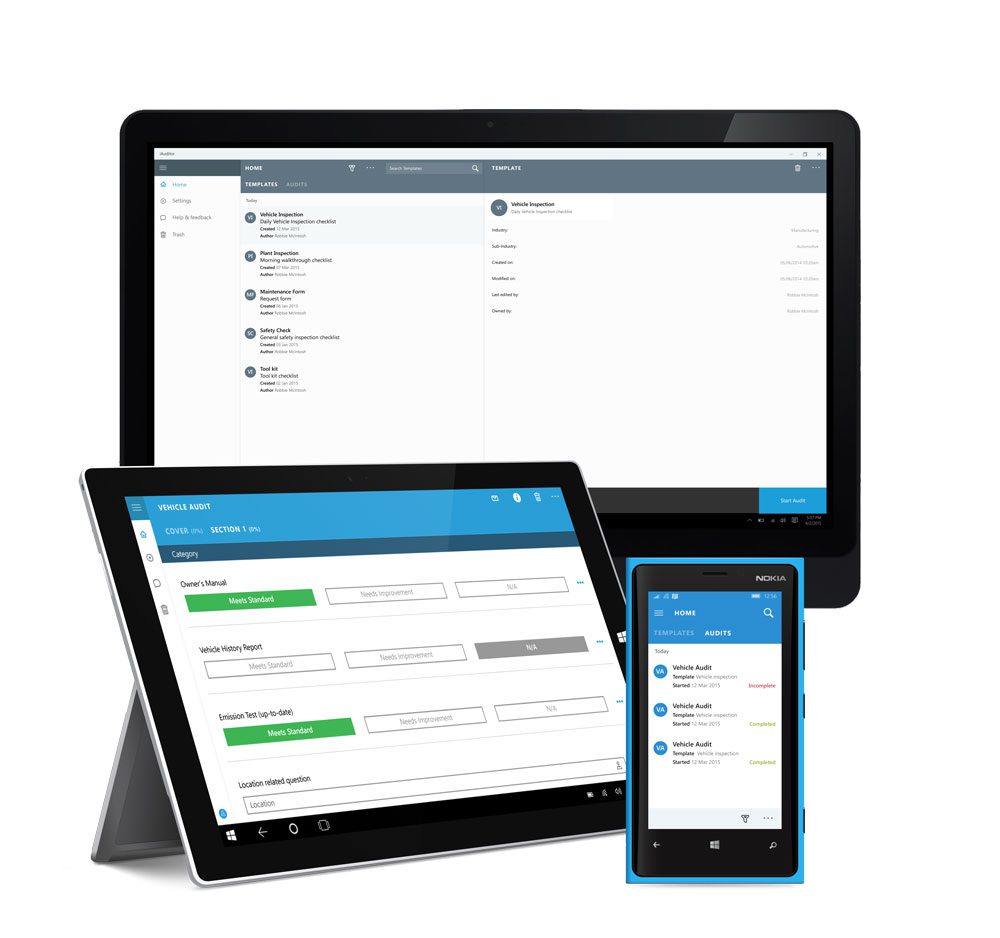Warren noted that he rarely used the Widgets panel or Microsoft Teams, citing that he preferred the weather display that later versions of Windows 10 offered, and didn't use Teams to communicate with his friends and family. He also acknowledged the expansion of Microsoft Store to include more "traditional" desktop applications. Overall, he concluded that "I wouldn't rush out to upgrade to Windows 11, but I also wouldn't avoid it. After all, Windows 11 still feels familiar and underneath all the UI changes, it's the same Windows we've had for decades."
In October 2019, Microsoft announced "Windows 10X", a future edition of Windows 10 designed exclusively for dual-touchscreen devices such as the then-upcoming Surface Neo. It featured a modified user interface designed around context-sensitive "postures" for different screen configurations and usage scenarios, and changes such as a centered taskbar and updated Start menu without Windows 10's "live tiles". Legacy Windows applications would also be required to run in "containers" to ensure performance and power optimization. Microsoft stated that it planned to release Windows 10X devices by the end of 2020. Internet Explorer has been replaced by the Chromium-based Microsoft Edge as the default web browser, and Microsoft Teams is integrated into the Windows shell.
Microsoft also announced plans to allow more flexibility in software that can be distributed via Microsoft Store, and to support Android apps on Windows 11 . Cunningham concluded that "as I've dug into and learned its ins and outs for this review, I've warmed to it more", but argued that the OS was facing similar "public perception" issues to Windows Vista and Windows 8. A redesigned user interface is present frequently throughout the operating system, building upon Fluent Design System; translucency, shadows, a new color palette, and rounded geometry are prevalent throughout the UI. A prevalent aspect of the design is an appearance known as "Mica", described as an "opaque, dynamic material that incorporates theme and desktop wallpaper to paint the background of long-lived windows such as apps and settings".
The Redmond giant has revealed that Windows 11 will be a free upgrade and start rolling out to eligible Windows 10 PCs and laptops on 5th October. The stable update rollout will happen in a phased manner, as expected. The upgrade will then roll out over time to in-market devices," adds the blog post.
Microsoft will consider the hardware requirements, reliability, age of the device, and other factors before making the Windows 11 update available on your PC. Windows 11 update is just around the corner and in a shocking revelation, not many people know. The world's most widely used desktop operating system is set to get a slew of improvements and new features, that are expected to boost the experience of users to another level altogether.
Amazing new features include the ability to even run Android apps on a Windows desktop for the first time ever. Now, a recent survey has claimed that only 38 percent of users know about the upcoming release of Windows 11, which is scheduled to arrive on Monday itself. Now, it's also important to mention that not all announced Windows 11 features will not be available on the release date. While you will get the new UI, sounds, and more when the stable update arrives, one of the most exciting features will be missing in action.
The redesigned Microsoft Store will roll out with the update, but it won't bring along Android app support, as promised. You will officially be able to install and use Android apps on your Windows device sometime in 2022. Microsoft is also upgrading the native apps experience with Windows 11. The company has released updates for several native apps like the snipping tool, calculator, photos app and more. All the updates bring these apps in line with the Windows 11 with Microsoft's design language, rounded corners, and support for dark mode. Microsoft is expected to upgrade all the remaining native apps in the future, providing a unified and clean experience to end users.
At least 16GB of RAM The basic system requirements of Windows 11 differ significantly from Windows 10. Windows 11 only supports 64-bit systems such as those using an x86-64 or ARM64 processor; IA-32 processors are no longer supported. Thus, Windows 11 is the first ever consumer version of Windows not to support 32-bit processors and 16-bit software . The minimum RAM and storage requirements were also increased; Windows 11 now requires at least 4GB of RAM and 64GB of storage. The compatibility list includes the Intel Core i7-7820HQ, a seventh-generation processor used by the Surface Studio 2, although only on devices that shipped with DCH-based drivers. As part of the minimum system requirements, Windows 11 only runs on devices with a Trusted Platform Module 2.0 security coprocessor.
According to Microsoft, the TPM 2.0 coprocessor is a "critical building block" for protection against firmware and hardware attacks. In addition, Microsoft now requires devices with Windows 11 to include virtualization-based security , hypervisor-protected code integrity , and Secure Boot built-in and enabled by default. The operating system also features hardware-enforced stack protection for supported Intel and AMD processors for protection against zero-day exploits. Citing security considerations, the system requirements for Windows 11 were increased over Windows 10. While the OS can be installed on unsupported processors, Microsoft does not guarantee the availability of updates. Windows 11 also drops support for 32-bit x86 CPUs and devices which use BIOS firmware.
Perhaps the most important thing to know about the release of Windows 11 is that we should expect it to change significantly over the next few years. I've been using beta versions of Windows 11 for a month in the lead-up to writing this review, and it seems like every few days there's a minor new feature or redesigned app to check out. We may not see that feature fully realized in Windows until next year. Original equipment manufacturers can still ship computers without a TPM 2.0 coprocessor upon Microsoft's approval. Devices with unsupported processors are not blocked from installing or running Windows 11; however, a clean install or upgrade using ISO installation media must be performed as Windows Update will not offer an upgrade from Windows 10. Some third-party software may refuse to run on unsupported configurations of Windows 11.
Windows 11 SE was announced on November 9, 2021, as an edition exclusively for low-end devices sold in the education market, and a successor to Windows 10 S. It is bundled with applications such as Microsoft Office for Microsoft 365, Minecraft Education Edition, and Flipgrid, while OneDrive is used to save files by default. Windows 11 SE does not include Microsoft Store; third-party software is provisioned or installed by administrators. Windows 11, the first major Windows release since 2015, builds upon its predecessor by revamping the user interface to follow Microsoft's new Fluent Design guidelines.
The redesign, which focuses on ease of use and flexibility, comes alongside new productivity and social features and updates to security and accessibility, addressing some of the deficiencies of Windows 10. In January 2021, it was reported that a job listing referring to a "sweeping visual rejuvenation of Windows" had been posted by Microsoft. A visual refresh for Windows, developed under the codename "Sun Valley", was reportedly set to re-design the system's user interface.
Windows 11 features a new version of the Microsoft Store, with a new interface and a broader selection of apps. This new store is meant to have an easier to use and better-curated digital storefront. It should also be faster, "We rebuilt for speed", said Panos Panay during the Windows 11 announcement. So far our experience of it is much the same as the rest of Windows 11...
But it's also still mostly filled with apps you'd likely download direct from your browser, or wouldn't want to touch at all. It's also worth noting that one of Windows 11's biggest new features, compatibility with Android apps will likely not be available for public release immediately at launch. Unveiled in June, Windows 11 is designed as Microsoft's most advanced operating system for PCs. The new version brings a fresh user interface that includes a centrally aligned Start menu and upgraded fonts as well as notification sounds. It also integrates Microsoft Teams to let users connect with others over chat, voice, or video calls.
It also supports multiple desktops and carries a range of accessibility features such as Narrator, Magnifier, Closed Captions, and Windows Speech Recognition. Windows 10 users will receive notifications to upgrade devices via the traditional system update feature. Alternatively, you can check when the upgrade is available for your computer via the Windows update section in the settings.
Microsoft plans to introduce an improved PC Health Check app to help users determine when a PC is eligible for the upgrade. The biggest change one will notice when they log in for the first time is the taskbar. Microsoft has improved the taskbar design which looks much more in line with the overall UI.
You can read more about the Windows 11 taskbar in our dedicated article on the topic. In June, Microsoft finally unveiled the much-anticipated Windows 11 update. It comes with an updated UI, and performance and productivity improvements. Microsoft also released the minimum system requirements for Windows 11 which includes Secure Boot and TPM 2.0 among other things. Following the announcement, Microsoft confirmed that it will start rolling out Windows 11 to existing Windows users from October 5. The taskbar's buttons are center-aligned by default, and it is permanently pinned to the bottom edge of the screen; it cannot be moved to the top, left, or right edges of the screen as in previous versions of Windows.
The "Widgets" button on the taskbar displays a panel with Microsoft Start, a news aggregator with personalized stories and content (expanding upon the "news and interests" panel introduced in later builds of Windows 10). Microsoft Teams is similarly integrated with the taskbar, with a pop-up showing a list of recent conversations. If the Microsoft Surface family of products isn't your style though, other brands like Dell, Asus and HP have all released pages online that specify what devices are Windows 11 ready. Note that many won't come with the new operating system installed, but as they all meet the minimum system requirements, you can simply buy the laptop or 2-in-1 as normal and then update it yourself.
Should I Wait For Windows 11 Update So far Microsoft has released the hardware requirements for Windows 11, but there's confusion over TPM and whether the company are pushing hard over the minimum threshold for which devices are eligible to be updated to the new version. After weeks of leaks and hype, Microsoft today officially announced Windows 11, the next version of its desktop operating system. Microsoft has previously suggested that those users working with Windows 10 right now will not get an update to Windows 11 until the year 2022. A combination of these two bits of information suggests we'll see the first hardware devices – NEW hardware devices – released with Windows 11 in around October of 2021. Despite the imminent launch date, the upgrade process will be slow, Microsoft says. Updates will be offered initially to new Windows 10 PCs/laptops and will then roll out to older eligible devices based on a few different parameters, including things like the age of the product and its internal hardware.
Microsoft expects to have finished the bulk of the Windows 11 upgrade by "mid-2022". Microsoft is taking a major leap with its all-new desktop operating system – Windows 11. The Redmond giant first shared details about Windows 11 back in June earlier this year. We learned about the best Windows 11 features, including the new UI, centered taskbar and revamped Start Menu, and Android app support in the Microsoft Store, among other things. But, the company had withheld the Windows 11 release date until today. Now, it has been confirmed that Windows 11 will release on 5th October, as announced via an official blog post.
None the less, Microsoft is listening to feedback from insiders running 7th generation Intel chips and collecting "more data about performance and security" so we will have to wait and see what they decide. There is chatter about some workarounds that may have their own limitations yet to be seen. These security updates however require Trusted Platform Module 2.0 chip to protect encryption keys and Windows 11 also requires systems have "more modern CPUs". To be specific on the CPUs allowed, Microsoft has a list of Windows 11 compatible CPUs showing mostly late 2017 and newer Intel 8th generation processors, and ~ 2018 and newer AMD processors. This announcement about the CPUs is unfortunate for some of us including me as I bought my system in 2016 and do not have a supported CPU.
In what is less surprising, the report also claims that users were also unaware of whether their computer was eligible to receive the update. The report states that the survey found two-thirds of users surveyed were not aware of whether their PC could run Windows 11. Microsoft is aiming to offer Windows 11 to all eligible Windows 10 devices by the middle of 2022, as announced through a blog post. Meanwhile, the Windows 11 upgrade will initially be available for newer Windows 10 PCs. New PC models from manufacturers including Asus, HP, and Lenovo have started coming with pre-installed Windows 11.
Microsoft is also bringing Windows 11 pre-installed to its new range of Surface devices that is coming to the US starting today. Windows 11 is now officially available for download in India and around the world. The new Windows operating system has been released as a free upgrade on eligible Windows 10 PCs.
It will also come preloaded on new Windows PCs from manufacturers such as Acer, Asus, Dell, HP, and Lenovo, among others. Windows 11 supports a variety of form factors such as convertibles and 2-in-1 devices alongside traditional desktops and laptops. It also works with a range of silicon from companies including AMD and Intel.
For details, seeMicrosoft's Security Update Guide and the November 2021 Security Update notes. It also fixes a bug that causes improper rendering of some user interface elements or when drawing within some apps. And it makes quality improvements to the servicing stack, which is the component that installs Windows updates. Microsoft has finally updated the Windows Ink Workspace, now called the "Pen menu" that gives you quick access to pinned apps that are designed with inking in mind.
What's great is that it's finally customizable, so you can put any app of your choice in there. It's accessible via a button shortcut on a physical pen, or via the System Tray as a shortcut for it pops up when you begin interacting with your device with a pen. For tablet users, Snap Assist will now intelligently snap apps above and below when using a device in portrait mode, a behavior that was missing in prior versions of Windows. Microsoft has also updated the switching orientation animation so that it's much more fluid, and also remembers where your apps were positioned when switching between landscape and portrait mode. Windows 11 will see a return of the widgets, albeit different from the ones we were used to seeing in Windows 7.
Microsoft has added a new Widgets button on the taskbar which opens a pop-up window to the side giving users easy access to weather, traffic, stock market updates, sports, news headlines and more. Microsoft will be collating data based on user preferences and it will be pulled from MSN. The feature is an extension to the News and Interest option that Microsoft added to Windows 10 earlier this year. We have covered Windows 11 Widgets extensively before and you can check out our article on the topic for more information on Widgets and how they will work. Microsoft has overhauled the Start Menu on Windows 11 and unfortunately, the Redmond giant's plans for the future does not include Live Tiles.
For better or worse, the start menu now consists of pinned apps as well as a recommendation section that suggests to you documents, and files based on your usage history. Unfortunately, the search bar is still unreliable and shows search results from Bing sometimes. Lastly, Microsoft has also moved the all apps section to the top right of the Start Menu so you will no longer get the app list when you open the Start Menu. You can check out more about the Start Menu in our Closer Look section.
Windows 11 will warn you that your PC isn't up to snuff, but will otherwise let you carry on your merry way. At the June 24 media event, Microsoft also announced that Windows 11 would be released in "Holiday 2021", with an exact date not given. Its release will be accompanied by a free upgrade for compatible Windows 10 devices through Windows Update.
On June 28, Microsoft announced the release of the first preview build and SDK of Windows 11 to Windows Insiders. To check for Windows 11 compatibility, download and run the PC Health Check app, which will identify specific compatibility issues that prevent an upgrade. Older hardware is less likely to pass Windows 11's stringent compatibility checks; for example, most Intel 7th Generation Core processors are not on the list of compatible CPUs, nor are PCs built using AMD Zen 1 processors. PCs purchased in 2016 or earlier are almost certain to be unsupported.



























